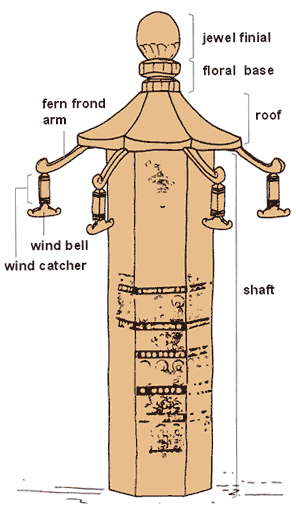Shagūji:
Yearning for the Pure Land of Supreme Bliss. The world of the “Scroll of the Hungry Ghosts” spreads.


Composite photo and scale drawing of the reconstructed hexagonal stupa Overall height is approximately 180 cm, with a greatest width of 58.8 cm. Made of wood in the shape of a hexagonal pillar, it is composed of a jewel finial and floral base of chestnut, a roof of wood from the Japanese raisin tree, and a shaft of hackberry tree wood. The roof was fitted at six points with sets of ornaments, each made of a fern frond arm of sumac, a wind bell of Japanese fir or hinoki (false cypress), and a wind catcher of hinoki or Sawara cypress.

Images of Amida Nyorai drawn on the shaft of the hexagonal stupa (graphically enhanced)
No pigment remains.
 |
 |
 |
 |
|
 |
 |
 |
 |
|
 |
 |
 |
 |
|
 |
 |
 |
 |
|
|
|
|
|
|
|
“Scroll of the Hungry Ghosts”
Hungry ghosts greedily drinking up water are visible at the left, along with a stupa.
Shagūji Site, Chikuma City, Nagano Prefecture
The Shagūji site is located in the Chikuma river’s western bank district, near the village of Sarashina famous from the legend of Obasuteyama, the mountain for abandoning the unwanted elderly. It is situated on an alluvial fan of the Sano river flowing from Mt. Hijiri into the Chikuma, at an elevation of about 36 m.
It is thought to be the site of facilities related to the Sarashina county seat of the ancient province of Shinano under the Ritsuryō system, and to have had some connection with the Ouna manor, one of the estates held by religious institutions, in the medieval period.
A hexagonal stupa unique for the entire nation is unearthed
A wooden stupa of a type known as rokkaku mokudō was recovered intact from where it had been discarded, within a large ditch partitioning the site. From radiocarbon dating it is placed at the end of the Heian period.
Made entirely of wood, it is comprised of three large components and six sets of ornaments. The three large components are the jewel finial, together with its floral base, the roof, and the shaft; the total height is estimated at 180 cm, and the width of roof at its greatest point is 58.8 cm. The ornaments consist of a fern frond arm, a wind bell, and a wind catcher as a single set, which are thought to have been attached at six point around the rim of the roof.
The shaft was finished in a hexagonal shape, and Buddhist images thought to be of Amida Nyorai were drawn on its surface. A single large Buddha image was at the topmost position, under which there were three tiers of three images each, for a total of ten images of Amida Nyorai making up a single surface.
As there are no previous discoveries of this type of stupa in Japan, this item is currently regarded as unique for the entire nation. A similar example is seen in the “Scroll of the Hungry Ghosts,” held to have been drawn at the end of the Heian period, which is inferred to have been the object of worship or an offering made for the repose of departed souls. One of the ornamental parts of the hexagonal stupa at Shagūji was recovered near the only burial discovered at the site, and from this the possibility arises that it was a memorial offering associated with that burial. Further, wooden effigies of swords and a bow were recovered from the burial, so it is thought that someone of high social standing was buried there.
The notion of mappō, the Age of Decline of Buddhist dharma, became widespread at the end of the Heian period. Through the discovery of the hexagonal stupa, it has been proved that the yearning to escape this world of suffering and seek salvation through entry into the Pure Land of Supreme Bliss, the precise situation seen in the “Scroll of the Hungry Ghosts,” had reached even the province of Shinano, far removed from the capital. (Machida Katsunori)
